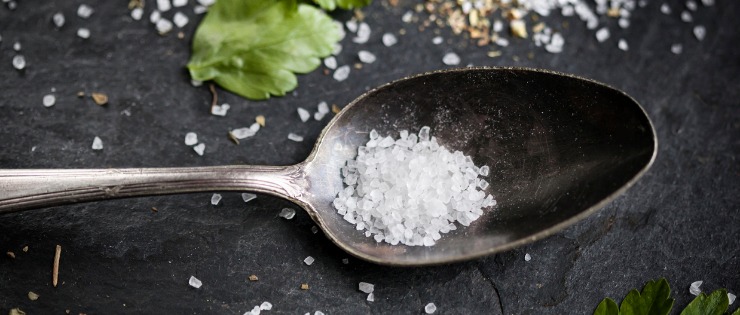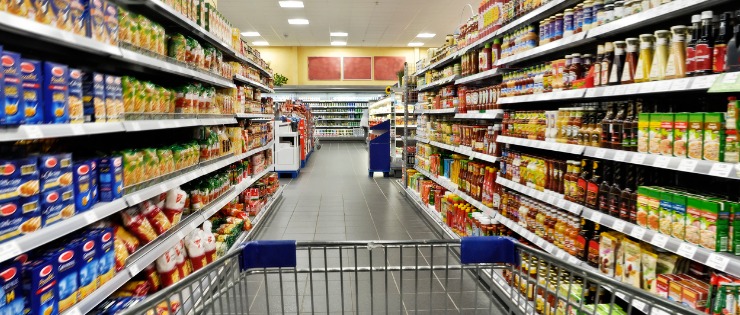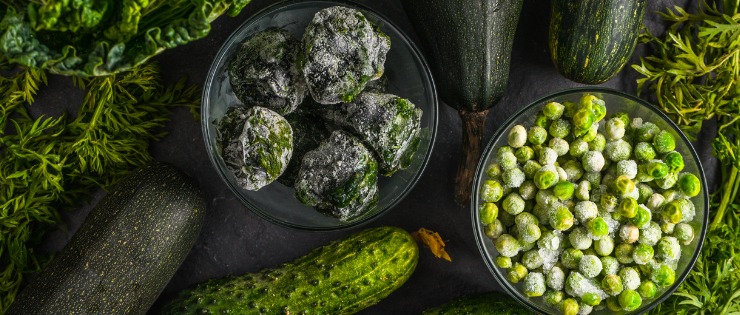
Most of us are eating too much salt. Worse still, many of us don’t realise just how much we are consuming because it’s hidden in many of the processed foods we eat.
Sodium is a vital nutrient, required to maintain healthy blood volume and blood pressure. It also plays an essential role in cellular osmosis - passing fluids into and out of the cells in your body.
While the terms salt and sodium and salt are often used interchangeably, it's the sodium in salt that is bad for you if you consume too much.
Regular table salt or cooking salt is one of the most common sources of sodium in our diet. Sodium is also found naturally in foods like meat and milk. Other food additives like sodium glutamate (MSG) are a source of sodium, particularly in processed food and restaurant meals. In fact, studies have shown that 75% of all sodium in our diet comes from processed food.
So, what are the health effects of eating too much sodium?
What Effect Does Salt Have on the Body?
We’ve all had a salty meal out in a restaurant only to wake up parched the next morning. Salt is absorbed in the bloodstream through the small intestines. The salty blood pulls water out of the body’s cells which then send messages to the brain telling us we’re thirsty and need to dilute the salt. The kidneys also work to dilute the salt by slowing down the production of urine.
What Does Too Much Sodium do to Your Health?
When your diet is high in sodium, it can cause a range of health problems in both the short and long term including:
Fluid Build Up - Fluid retention occurs when fluid is trapped in the tissue and skin, causing swelling. Also known as oedema, too much salt in your diet can cause the fluid imbalance.
High Blood Pressure - Too much sodium reduces your kidneys’ ability to remove water from your bloodstream which causes high blood pressure. As we age, our blood pressure slowly increases but diet is the biggest cause of high blood pressure.
Loss of Calcium - When your diet includes too much salt, the body excretes it through the urine however it takes calcium with it. Calcium in the urine can lead to kidney stones and lost calcium stores can cause thin bones and osteoporosis.
Kidney Disease - A major risk factor for the decline in kidney function is the amount of protein in urine. When the protein is excreted, it increases the deterioration rate of renal function which causes kidney disease.
Congestive Heart Failure - When fluid builds up it elevates blood pressure, and can weaken the heart and damage arteries so the heart can’t pump blood effective and congestive heart failure can occur.
Stroke - High blood pressure can damage arteries leading to the brain. Too much salt over a long period can cause arteries to burst or become clogged and a part of the brain doesn’t get the oxygen and nutrients it needs so it dies. After a stroke, the body can’t do things that part of the brain controls.
Recommended Daily Sodium Intake
The American Heart Association recommends adults consume no more than 2,300 milligrams of sodium per day but the ideal limit is 1,500 mg a day.
Many people are eating well above the recommended amount at up to 3,400 mg a day. To put it into the perspective of table salt, ¾ of a teaspoon of salt is the equivalent of 1,725 mg of sodium.
However, a 2013 study found that lowering your sodium below the recommended 2300 mg per day does not seem to bring additional health benefits.
This same study did find evidence for an association between higher salt intake and an increased risk of heart disease.
An Overall Healthy Diet Can’t Offset High Salt Intake
Even if you eat all the other vitamins and minerals your body needs for good health and keep your weight in the healthy Body Mass Index (BMI) range, it doesn’t counter the damage of too much salt. Salt causes short- and long-term health problems. The only way to reduce the risk of too much sodium is to consume less sodium.
Can You Consume Too Little Sodium?
Our bodies need salt to function properly but according to the American Heart Association, it is a tiny amount. Less than 500 milligrams of sodium (or less than ¼ teaspoon) is all that’s needed for healthy bodies.
In Western society, few people have to worry about not getting enough sodium. Only people who sweat a lot such as athletes and those working in very hot climates, need not reduce their daily intake to 1,500 mg. The upper limit of 2,300 mg ensures the salts they lose through sweat are being replaced in their diet.
Processed Food and Sodium - The Hidden Health Risk
Some people think they are well within the recommended daily salt intake because they don’t cook with salt or put a salt shaker on the dining table like their parents did. But what they don’t consider is the hidden salt they consume in processed food.

How Much Sodium is in Processed Food?
In many processed foods, it’s an awful lot of sodium. Even with foods where you are more worried about the high sugar content such as doughnuts, fruit muffins and sweet pastries, also consider the amount of sodium.
What Foods are High in Sodium?
The following list of common foods have high salt contents that can eat up much of our Recommended Daily Intake (RDI) of salt. The percentage of RDI is based on the American Health Association’s upper limit of 2,300 milligrams of sodium per day. The RDI percentages would be much higher if they used the recommended limit of 1,500 mg.
Pasta Sauce – a 90g serve has an average salt content of 0.75g (13% RDI)
Ham Slices – a 50g serve has an average salt content of 1.98g (34% RDI)
Salad Dressing – a 20 ml serve has an average salt content of 0.36g (6% RDI)
Canned Soup - a 200g serve has an average salt content of 1.4g (24% RDI)
Pizza – a 300g serve has an average salt content of 3.74g (65% RDI)
Lasagne – a 400g serve has an average salt content of 2.42g (42% RDI)
Bacon – a 50g serve has an average salt content of 1.47g (25% RDI)
Honey Soy Marinade – a 20 ml serve has an average salt content of 0.77g (13% RDI)
Cheese – a 50g serve has an average salt content of 0.98g (17% RDI)
Soy Sauce – a 5ml serve has an average salt content of 0.5g (8.7% RDI)
BBQ Sauce – one tablespoon has an average salt content of 0.56g (9.4% RDI)
Fruit Muffin – an 85g serve has an average salt content of 0.72g (12% RDI)
Bread – two slices has an average salt content of 0.76g (13% RDI)
Dip – a 30g serve has an average salt content of 0.36g (6.2% RDI)
Crackers – a 10g serve has an average salt content of 0.18g (3% RDI)
Many of these serving sizes are small compared to what some people consume and the bigger the portion size, the bigger the salt hit. While you need not cut these foods out of your diet, you need to consider them in terms of your daily intake of salt.
For example, if you have a ham and cheese toasted sandwich at lunchtime, don’t have a helping of chicken in honey soy marinade with a side of fried rice in the evening. You will be well over the recommended daily salt intake.
Why Are So Many Foods High in Sodium?
Food manufacturers load processed food with salt for two main reasons:
Preservative Effect
Salt is made up of sodium and chloride ions which reduce the water activity of foods so food lasts longer. Water activity supports the growth of bacteria and other chemical reactions that cause food to spoil. By adding sodium and sodium-containing preservatives, food lasts longer.
Flavour Enhancement
Salt enhances the flavour of most foods and our taste buds are used to eating salty foods. Sweet food also tastes better with salt. Some manufacturers don’t use salt but use large quantities of different sodiums in food. Flavour enhancer, sodium acetate, suppresses the bitter and enhances sweet flavours in food. Monosodium glutamate enhances the flavour of some savoury foods.
Can Processed Food be Healthy?
Manufacturers process many foods we eat today for a variety of reasons. Processing extends the life of canned food like fruit, vegetables and fish. Some foods are processed to make them safer to eat e.g. pasteurising milk. Some fortifying processes improve the nutritional value of food by adding fibre or calcium. Processing can increase the convenience of some foods e.g. washing and chopping vegetables before bagging.
Some foods are minimally processed (frozen vegetables, bagged salad leaves) while others are ultra processed (potato chips, frozen meals). Minimally processed foods usually contain little sodium or any other additives so they are healthy.
With highly-processed foods you should check the list of ingredients and pay attention to the sodium, sugar and fat content.
We shouldn't only pay attention to sodium levels in processed food. Ultra-processed foods are responsible for 90% of added sugar and 60% of all calories in the average US diet a 2016 research study found.
How to Choose Healthier Processed Foods
Small changes to your food choices can have a big impact on the amount of salt you consume.
Read the Labels
When you are shopping, look at the list of ingredients on the back of the packet and try to buy products that have a salt content that is <400mg per 100g. Even better if you can find foods that are <120 mg per 100g.
Enjoy Frozen and Canned Vegetables
You can still enjoy the convenience of frozen or canned vegetables without sacrificing the nutritional value. Vegetables are often processed within hours of being picked so they are still high in vitamins and minerals when you are ready to prepare them. Watch out for canned vegetables with sugar syrup or too much salt. Frozen is usually a better choice - frozen veggies have the same level of vital nutrients as fresh vegetables.

Look for the Heart Tick
Choose processed foods labelled with the American Heart Association’s Heart-Check mark or Australia’s heart tick because the organisation has assessed the food’s salt, sugar and fat content.
Swap Highly Processed for Less Processed Food
Think about how you can enjoy more foods close to their natural state. Nuts, fruit and vegetables make far healthier snacks than highly processed biscuits and potato chips.
Plan Your Recipes
Have a list of recipes on hand that are quick and easy to prepare at night that use foods you most often have in the pantry or fridge. Rather than ordering a take out meal or heating the frozen pizza, make one of these meals.
Get the Kids Involved
If you have a young family, involve the kids in preparing snacks and meals. Tell them the names of fruits, vegetables and how to cut them up. Show them how to measure and mix rather than opening jars and bottles.
Think About How your Grandparents Ate
There was little fast food or processed foods available in our grandparents’ day. They ate a ‘clean’ diet because everything was prepared from scratch. Take the lead from your grandma and switch from processed to home made. This allows you to take control and decide exactly how much salt and sugar you want to add to your food.
Converting Sodium and Salt
It can be confusing when packaged food lists sodium not salt as the ingredient - you may wonder how the amount of sodium relate to the number of teaspoons or tablespoons of table salt. Table salt comprises 40% sodium and 60% chloride.
Here are the rules for converting sodium to salt and salt to sodium:
Sodium to Salt
Multiply the sodium in milligrams figure by 2.5 then divide by 1,000.
i.e. 200 mg of sodium x 2.5 = 500mg ÷ 1,000 = 0.5 grams of salt
So 200mg of sodium is equal to 500 mg salt (0.5g salt)
Salt to Sodium
Divide the salt in grams figure by 2.5 then multiply by 1,000
i.e. 5 g of salt ÷ 2.5 = 2 grams of sodium x1,000
So 5 g of salt is equal to 2,000 mg of sodium
If you are unsure how much sodium you are consuming, try keeping a food diary for a week. Look through the list to see how many of your meals and snacks are processed foods with a high salt content.
In conclusion - the health consequences of consuming too much sodium are real and well documented. Be aware of how much salt you use when cooking and, most importantly, reduce your intake of highly-processed foods to stick to a low sodium diet.